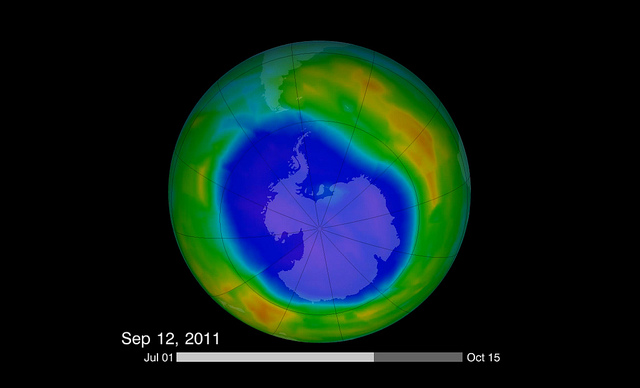This month’s conclusion to this two-part article looks at some of the legal and policy factors that made the Montreal Protocol possible and successful, and how those may inform efforts to produce a climate treaty. (If you haven’t read Part 1, you can here.)
In 1974, an article in Nature suggested that widespread use of chlorofluorocarbons (CFCs) may be depleting stratospheric ozone fast enough to increase rates of melanoma and possibly disturb the earth’s oxygen cycle. As a result, the federal government created a 14-agency Interagency Task Force on Inadvertent Modification of the Stratosphere (IMOS) in early 1975 to study the issue. In September that year, Congress held a series of hearings regarding what legal action, if any, it should take in response. Sherry Rowland testified that data collected since the Nature article was published was “in good agreement” with his original findings, stating, “[s]cientifically, I think the case for an ultimate ban is quite clear.” Others, including industry representatives, NASA’s administrator, and the IMOS co-chairs, urged delaying action until further evidence was available, including a National Academy of Sciences study expected in early 1976.
The concern over ozone depletion was great enough, though, that EPA administrator John Quarles cited it as a specific reason for Congress to create a Toxic Substances Act granting EPA authority to regulate such substances. Basically, the EPA saw market failures and sought legal authority to create regulations to address those failures and the externalities they create. After Congress passed the Toxic Substances Control Act (TSCA – pronounced “tosca”) in October 1976, EPA administrator Russell Train listed ozone depletion by CFCs as one of two hazards the EPA would immediately address with the new law. TSCA provided the EPA broad authority to study the toxicity of chemical substances and mixtures, to regulate any “which present an unreasonable risk of injury to health or the environment, and to take action with respect to chemical substances and mixtures which are imminent hazards.” By 1978, EPA had used this legal authority to issue regulations banning the use of CFCs as propellants in spray containers, but not in broader applications or as refrigerants. CFC manufacturers argued that the science was too uncertain to warrant legal bans on CFCs. Further laws regarding CFCs would have wait.
By 1981 the issue had risen to truly global concern and the United Nations Environment Program (UNEP) established a working group to draft a global framework convention on stratospheric ozone protection intended to produce an international treaty on controlling ozone depleting substances. From a chemical and environmental standpoint, an international ban would be essential since a CFC molecule obeys physical and chemical laws, paying not heed to national boundaries. As a legal matter, though, international treaties are tricky business. They require the adoption and enforcement by some critical threshold of nations. In the U.S., international treaties can only be adopted with consent of a supermajority of the Senate. EPA could not act on its own.
Two principal camps emerged early in international negotiations. The U.S., Canada, and the Scandinavian countries had already banned nonessential aerosol use of CFC domestically and favored a strict or complete ban on global use. Others, led by countries in the European Economic Community, wanted a partial rather than total ban. In March 1985, the parties finally agreed on a “convention,” the Vienna Convention for the Protection of the Ozone Layer. In UN parlance, a convention is an agreement to make a treaty, sort of an agreement to eventually agree. Certainly this was some progress, but not a binding treaty. Two events soon provided the catalysis needed to for negotiations to proceed at a faster rate.
First, in May 1985 scientists with the British Antarctic Survey reported their data on ozone concentrations over Antarctica. The levels were much lower than anyone had predicted by that point. News stories began to propagate of an ozone layer “hole” and with them increased pressure for an international CFC ban. Second, the world’s largest CFC manufacturer, DuPont, concluded that CFCs were depleting ozone and saw a viable business opportunity. While ramping up sunscreen production may have seemed attractive, the company took the lead in developing and marketing CFC substitutes. Two years later, the Parties to the Vienna Convention agreed to a treaty, the Montreal Protocol on Substances that Deplete the Ozone Layer.
The Montreal Protocol and its amendments set out legally binding requirements to phase out production and use of CFCs and other particularly powerful ozone depleting substances by 1996. It also created a schedule for phasing out the “transitional” replacement HCFCs by 2030. By most accounts, it appears that the law has produced the intended result. Atmospheric concentrations of CFCs and other ozone depleting substances have either leveled off or declined. Recent surveys of the ozone layer above Antarctica suggest that ozone concentrations there are on a general upward trend and that the area of low concentration is shrinking. So far, so good. If only we could get the same factors to line up on climate.
What do I think is missing? First, I really think the public hasn’t become galvanized by a signal event that so obviously is linked to greenhouse gas emissions in the way that the “ozone hole” images swayed public opinion about CFCs. Second, and I think this may be the most critical point, the CFC industry was much smaller and narrower than the (mostly energy) industries that lead to GHG emissions. This made it much easier for industry to see a business case for developing substitutes and thus support the treaty. Some critics have complained that CFC manufacturers only got on board because they could make money. But maybe that’s not so bad.
Maybe a few “climate billionaires” getting rich by halting climate change is what it will take. If that happens fast enough there may still be some nice tropical islands in the Pacific far enough above sea level worth purchasing with all that money. Speaking of, I think it may be time to get back to planning my own little trip south. Thanks to the Montreal Protocol, I can probably still plan to pack just one bottle of sunscreen. Here’s hoping for a similar climate treaty that would make sure those islands will be able to keep their heads above water for decades to come.




